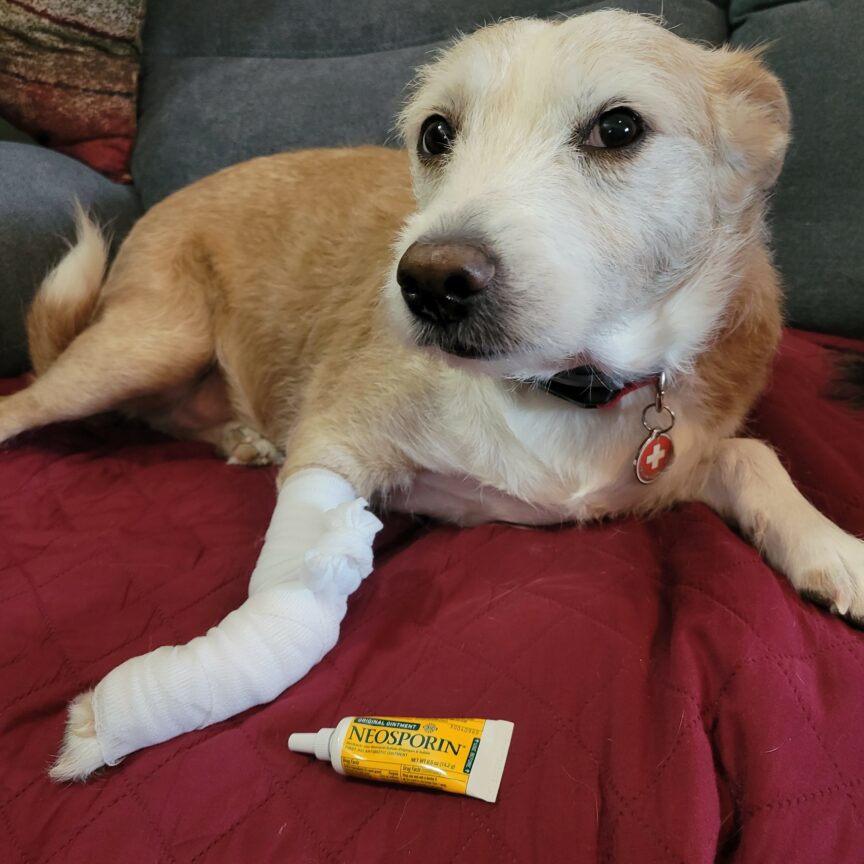By Arden Moore
Pro Pet Hero Instructor Director and Master Pet First Aid/CPR Instructor
When you get a scratch, you may grab the Neosporin from your medicine cabinet shelf. But should you apply this antibiotic ointment on a minor wound on your dog?
The answer: it depends.
It depends on the type of wound, the location and if your dog tends to lick any boo-boos on his body.
In the two-day Pro Pet Hero instructor program and the Pet First Aid 4 U classes I teach, students are often divided as to whether Neosporin is safe to use on dogs. So, I am here to unleash these facts backed by leading veterinarians.
First, recognize that Neosporin is quite safe to use on people. It was formulated for people to hasten the healing of minor cuts and scrapes. It is not intended to use on any deep gashes, serious burns or bite wounds. And, although there are a variety of Neosporin products, there are no canine-formulated versions of this popular over-the-counter product.
Be aware that the most popular type of Neosporin contains three types of antibiotics: bacitracin zinc, neomycin sulfate and polymyxin B sulfate. Together, this trio’s mission is to destroy any bacteria on the skin, halt any topical skin infection and create a physical barrier between the skin and disease-causing pathogens.
Fortunately, there have been no reports of Neosporin being toxic in dogs. However, some dogs have developed allergic reactions to these ingredients and may develop rashes or hives. And, if the treated wound is not wrapped in gauze and within licking range, some dogs who swallow these antibiotics can contend with stomach issues, diarrhea and vomiting.
Definitely do not apply Neosporin on any deep gashes, burns or bite wounds. Seek immediate veterinary treatment for those.
Please quickly report any negative reactions of Neosporin to your veterinarian. I also recommend keeping the ASPCA Animal Poison Control toll-free number of 888 426-4435 in your phone. This center is staffed 24-7 by board-certified veterinary toxicologists.
So, what’s the safer option to treat a minor cut or scrape on your dog? First, clean the wound with antibacterial soap and water. Rinse it and pat it dry. Prevent your dog from licking or scratching the wound by fitting him in a medical collar and/or covering the wound in gauze wrap that you change daily.
Get your veterinarian’s advice on using other options to clean and treat wounds. Among the natural options are:
Healing clays. Look for Bentonite or Redmond clays used to stop bleeding and ease any itchiness.
Calendula. This herb comes in salves, tinctures and creams and is noted to prevent infections and fight inflammation.
Over-the-counter ointments containing polysporin, such as Burt’s Bees Res-Q Ointment or Curoxen. Hydrocortisone is a safe topical cream to aid irritated or itchy skin.
Never use hydrogen peroxide to treat a wound on your dog. It not only kills the bacteria, but also destroys healthy skin around the wound which is vital to proper wound healing.
Keep tabs on the healing progress and contact your veterinarian if you notice any increased redness, swelling or evidence of pus on the wound site.
Learn Pet First Aid
Learn more on ways to keep your cats and dogs safe by visiting http://www.propethero.com. Consider taking our veterinarian-approved online pet first aid/CPR course. Enter this code: CPR – ARDEN MOORE and receive a 10 percent discount! And, if you are interested in becoming a Pro Pet Hero instructor, please click on the BECOME AN INSTRUCTOR button on the home page for more details.

